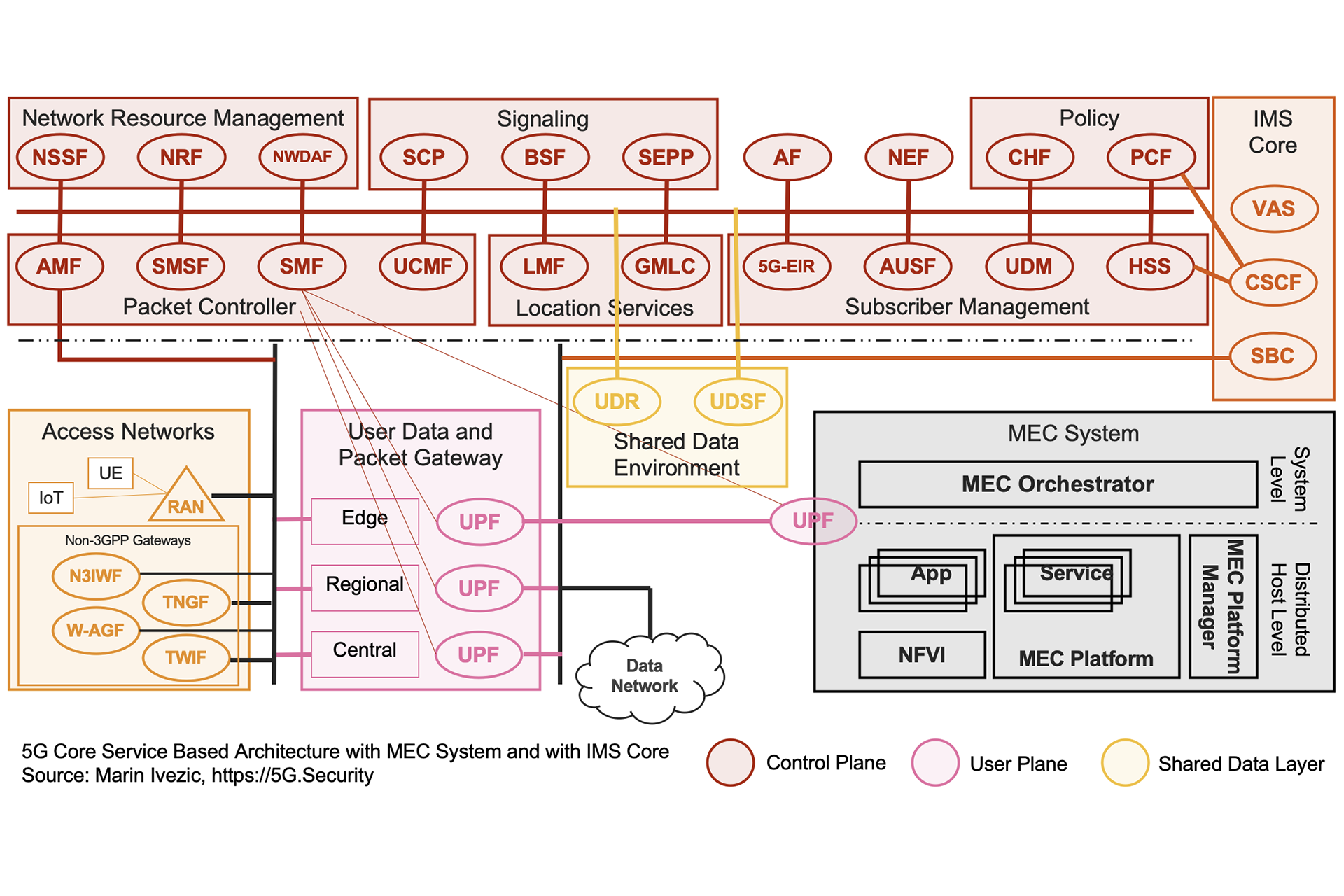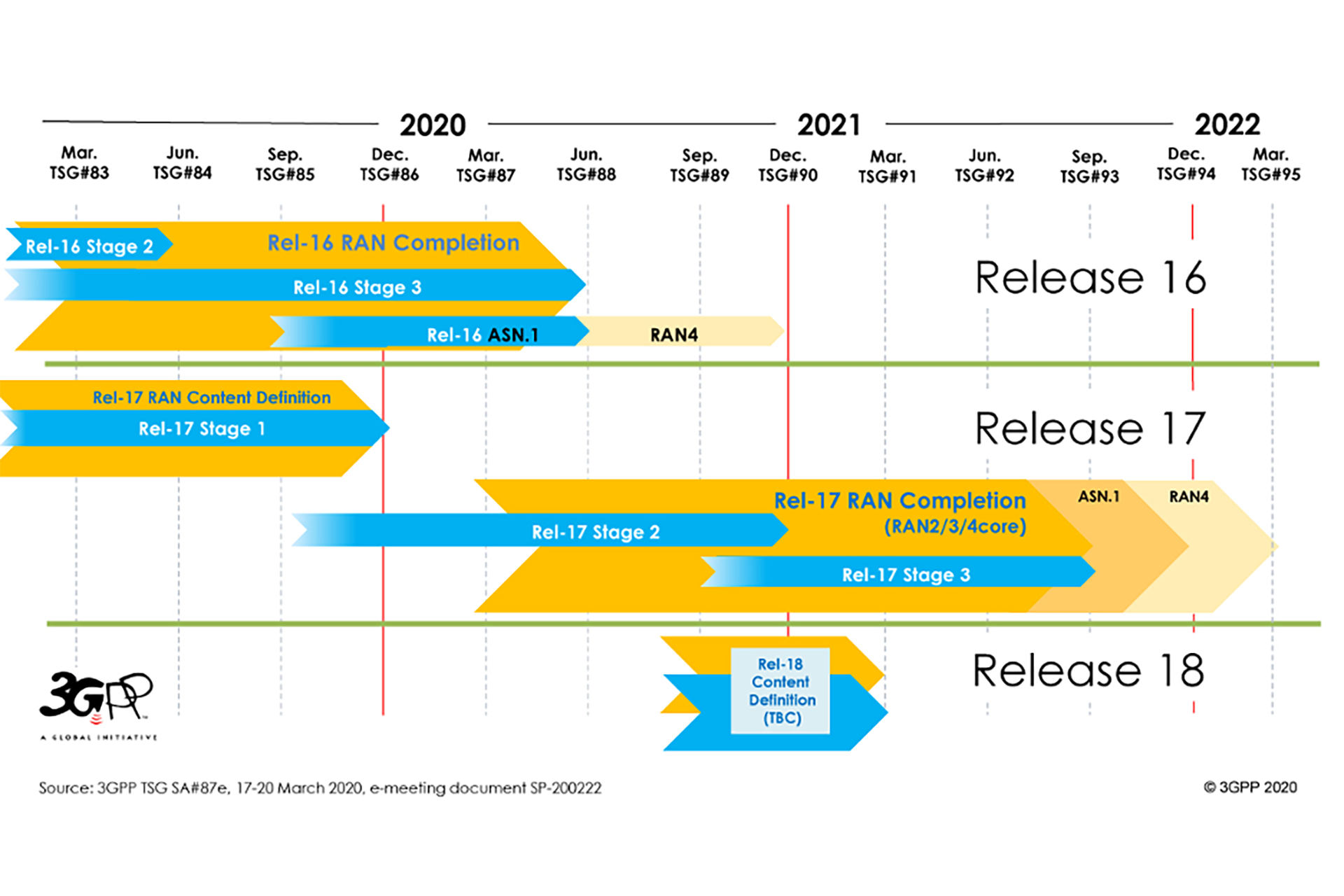5G in Manufacturing – 5G and Time Sensitive Networking (TSN) for Industrial Automation

In the recent report by IHS Markit – “The 5G Economy – How 5G will contribute to the global economy” – researchers claimed that manufacturing will garner almost $4.7 trillion in sales enablement by 2035. Or 36% of the $13.2 trillion total opportunity of 5G by 2035. Manufacturing will be by far the largest industry beyond mobile to be impacted by 5G.
In the manufacturing sector the adoption will benefit in the short-to-medium term from enhanced indoor wireless broadband coverage. Other early use cases include asset tracking such as visibility over incoming and outgoing components and goods in the supply chain; remote access solutions that enable remote machine maintenance from the internet; and industrial automation, such as continued automation of robots and connectivity for moving assets such as AGVs.
5G provides many of the network characteristics essential for manufacturing such as low latency, high reliability and high connection density. These are requirements that manufacturers currently rely on fixed-line networks. The 5G technology will allow for higher flexibility, lower cost, and shorter lead times for factory floor production reconfiguration, layout changes, and alterations.
The most impactful and most critical use cases, however, will also require network protocols that, more than “traditional” IT protocols include elaborate mechanisms to provide fault-tolerant network paths and precise time synchronization. As modern industrial networks are changing from communication architectures with strong compartmentalization towards communication from the sensor to the cloud, time synchronization becomes even more important. These use cases require precise time synchronization all the way down to device level.
In industrial automation information about physical events captured by wirelessly-connected and spatially-distributed sensors have to be synchronized. Individual devices must be carefully synchronized to project the relative chronological order of occurrences and extract correlation patterns in the event. Time synchronized coordination among machines and robots is crucial. In particular in closed-loop motion control, such as in packaging, printing, symmetrical welding, etc. in which machines execute meticulously sequenced real-time tasks isochronously.
Such time synchronization is also required for energy efficient radio scheduling and distributed coordination within the network.
Therefore, to realize all of the intended benefits of 5G-enabled industrial manufacturing, we need to add to the mix a deterministic, real-time communication with very accurate time synchronization.
In this article I will try to explain the importance of Time Sensitive Networking in the context of Industry 4.0. The time sensitivity requirements of the various industrial application (including periodic/deterministic, a-periodic/deterministic and non-deterministic) are examined. The building blocks of the TSN standard (IEEE 802) including Traffic Shaping, Resource Management, Time Synchronization and Reliability are explained. Finally, the enablement of Time Sensitive Networking for Industrial Automation with URLLC in 5G is discussed.
Industry 4.0
The world has seen industry evolve over time. At certain stages there has been a “revolution” vs an evolution:
- 1st Revolution: “Steam power” introduced to mechanize industrial production ~ Late 18th Century
- 2nd Revolution: “Mass production” pioneered by automotive manufacturers ~ Early 20th century
- 3rd Revolution: “Digital” or programmable electronic systems, robots automate production lines ~ Early 1970s
- 4th Revolution: “Internet of Things” with time sensitive connectivity to the cloud to maximize automation

The 4th industrial revolution is based on:
- Internet of Things (IoT) that increase automation, improve communication and self-monitoring
- Smart machines that analyze and diagnose issues without the need for human intervention
- Increased sharing of data across multiple systems and participants in the manufacturing process
A critical component to enable Industry 4.0 is industrial IoT.
Connectivity Evolution for Industrial IoT
According to Omdia, “Connectivity is one of the fundamental pillars upon which the industrial IoT (IIoT) is built. And over the last few decades, industrial connectivity, in particular, has evolved considerably, especially in response to the ever-changing requirements of the manufacturing industry.” The article continues to illustrate how industrial connectivity has evolved over the past 4 decades:
- 1980s: “Discrete wires” to communicate with field devices
- 1990s: “Fieldbus” industrial networking technology and a controller to communicate with field devices
- Today: “Ethernet” is deployed with the fieldbus and wireless technologies
- 2020+ Time-Sensitive Networking (TSN) will be deployed

The time sensitive nature of industrial automation is explained by an example from high speed packaging:
- Machines that filling, jars or bottles with food products need millisecond level precision in the timing of signals that control the process of placing, filling, removing and sealing the containers.
- A warning from a machine tool that it has for some reason failed fully to offload the component it has just manufactured must reach the robot seeking to load the next component before it makes the attempt.
- Missed connections and millisecond delays in communication between robotic systems can cause products and perhaps production machines to become unsynchronized, often leading to damaged products or even damaged machines.
The same article mentions another example of a failure with catastrophic consequences is failure of a system to respond immediately to a warning of over-pressure in a boiler.
Time Sensitive Requirements in Industrial Automation
Industrial systems therefore need to guarantee an event will occur precisely when expected. It is essential to ensure that events happen exactly when they are supposed to happen and that there is no scope for variability. Industrial ethernet due to its Carrier Sense Multiple Access (CSMA) nature cannot provide this level of determinism for industrial networking. In an IEEE paper the authors mention multiple industrial IoT use cases that require low latency. These industrial automation use cases referenced have the following traffic requirements:
- Deterministic, periodic with stringent latency requirements
- Motion control responsible for controlling moving and/or rotating parts of machines (e.g. printing machines, machine tools or packaging machines)
- Control-to-control communication between industrial controllers e.g. an assembly line
- Mobile robot able to fulfil a large variety of tasks usually following programmed paths
- Deterministic, aperiodic with lesser stringent latency requirements or non-deterministic requirements
- Mobile control panels with safety functions (safety panels) used for configuring, monitoring, and controlling machines, robots, or production lines. Safety control panels are also typically equipped with an emergency stop button. They require transmission of non-critical data (non-deterministic traffic) for the configuration, monitoring, and maintenance of the machines. They also require the transmission of highly critical and unpredictable safety data with stringent latency requirements (deterministic aperiodic traffic) when pressing the emergency stop button.
- Process automation (P.A.) – closed-loop control, for example when several sensors are installed in a plant and each sensor makes continuous measurements. The latency and determinism in this use case are crucial. Closed-loop control produces periodic and aperiodic traffic with strict latency requirements (i.e. deterministic traffic). The traffic is aperiodic if for example the sensor only transmits data when a certain threshold is exceeded. It is periodic if the sensed data must be periodically transmitted to maintain the industrial process active.
- Process automation (P.A.) – plan asset management: In this use case, sensors collect data about assets. This data must be transmitted for storage and processed within a defined time interval (deterministic aperiodic traffic). This data is used to continuously diagnose assets and components and be able to detect (and even predict) any possible degradation.

Time-Sensitive Networking (TSN)
Time-Sensitive Networking (TSN) is a key technology to realize this fundamental change. TSN is a set of IEEE 802 Ethernet sub-standards, defined by the IEEE TSN Task Group that enables deterministic real-time communication.
In article on Time Series Networking and 5G by Ericsson: “TSN provides guaranteed data delivery in a guaranteed time window; that is, bounded low latency, low-delay variation and extremely low data loss. TSN supports various kinds of applications having different QoS requirements: from time- and/or mission-critical data traffic, for example, closed-loop control, to best-effort traffic over a single standard Ethernet network infrastructure; in other words, through a converged network. As a result, TSN is an enabler of Industry 4.0 by providing flexible data access and full connectivity for a smart factory.“

The main goal of a Time Sensitive Network is to provide deterministic services over IEEE standard 802.3 Ethernet wired networks. This means guaranteed packet transport with low and bounded latency, low packet delay variation, and low packet loss. TSN features can be enabled for specific data streams in a network that also handles best effort type of traffic.
TSN enables deterministic data transfer by splitting time into repeating cycles by means of the TDMA (Time Division Multiple Access) method. Within these periods, time slots are reserved for high priority data streams, which need to be protected from other network transmissions. This creates virtual channels from one terminal device connected to the network to another. These channels are closely linked to the internal clocks of the participating network members. In order to achieve high precision for time synchronization, TSN usually uses the Precision Time Protocol (PTP) in accordance to IEEE1588.
TSN has typically been targeted at wired networks because it requires very low latency. TSN focused on the link layer of the network, which is different from the 3GPP 5G standards or the 802.11 Wi-Fi communications standards focused on the communications layer of the network.
However, the latest 5G and 802.11ax Wi-Fi (Wi-Fi 6) standards, which support ultra-reliable low latency communications (URLLC), make TSN over wireless networks an exciting possibility. These standards introduce different scheduling mechanisms than previous wireless standards allowing for a more efficient scheduling of simultaneous transmissions from multiple devices. This can eliminate delays, and can make it possible to provide bounded latency and high reliability in wireless communications. Something that was practically impossible previously.
As an example of 5G and TSN integration, Qualcomm has showcased this in a trial with Rexroth, a Bosch Company. Industrial devices use time-sensitive networking (TSN) technology while operating over a live 5G network by taking advantage of 5G URLLC features available in 3GPP Release 16.

The TSN Toolbox Explained
TSN standards can be seen as a toolbox that includes several valuable tools categorized into four groups – Traffic Shaping, Resource Management, Time Synchronization and Reliability.
- Traffic shaping guarantees the worst-case latency for critical data by various queuing and shaping techniques and by reserving resources for critical traffic:
- Resource management is defined by the TSN configuration models (802.1Qcc)
- Centralized Network Configuration (CNC) can be applied to the network devices (bridges),
- Centralized User Configuration (CUC) can be applied to user devices (end stations).
- Time synchronization is based on the generalized Precision Time Protocol (gPTP) (802.1AS),
- Reliability is provided by Frame Replication and Elimination for Reliability (FRER) (802.1CB) for data flows through a per-packet-level reliability mechanism.
- It provides reliability by transmitting multiple copies of the same data packets over disjoint paths in the network.
- Per-Stream Filtering and Policing (802.1Qci) improves reliability by protecting against bandwidth violation, malfunctioning and malicious behavior.

Time-Sensitive Networking Profile for Industrial Automation is referred to as IEC/IEEE 60802 specifies the application of TSN for industrial automation, and also gives guidelines to what 5G needs to support.
5G Specifications and TSN Requirements
3GPP 5G NR Release 16 specification is focused on enabling Industrial Internet of Things (IIoT) communications. Release 16 includes latency and reliability enhancements that build on the already very low air-interface latency and high reliability provided by Release 15. Release 16 approach is to integrate TSN over the top. TSN time domain information is distributed between the TSN translator functions in the network and the device using the 802.1AS standard protocol. More work is expected to occur in 3GPP Release 17.
5G specification includes several functionalities especially around the 5G New Radio (NR) that can be mapped to the TSN requirements:
- Low Latency in 5G NR is enabled by shorter slots in a radio subframe, which benefits low-latency applications. NR also introduces mini slots, where prioritized transmissions can be started without waiting for slot boundaries, further reducing latency.
- Resource Management 5G NR introduces preemption – where URLLC data transmission can preempt ongoing non-URLLC transmissions. Additionally, NR applies very fast processing, enabling retransmissions even within short latency bounds.
- Reliability – 5G defines extra-robust transmission modes for increased reliability for both data and control radio channels. Reliability is further improved by various techniques, such as multi-antenna transmission, the use of multiple carriers and packet duplication over independent radio links.
- Time synchronization is embedded into the 5G radio systems as the radio network components themselves are also time synchronized, for instance, through the precision time protocol telecom profile. This is a good basis to provide synchronization for time-critical applications.

In the Ericsson white paper 5G evolution: 3GPP Releases 16 & 17 overview, the authors describe how Industrial IoT integrates with the TSN spec via 5G.

5G support for TSN is still a work in progress. If you want to check in more detail the current specifications, the most relevant clauses are:
- TS 23.501 clauses 4.4.8, 5.27, 5.28, Annex H, Annex I on support for TSN and clauses 5.6.10.2, 5.7.6.3, 5.8.2.5.3 on Ethernet forwarding;
- TS 23.502 Annex F on support TSN;
- TS 23.503 clause 6.1.3.23 on support for TSN.`
Flexible 5G Frame Structure
5G NR defines multiple numerologies to support Enhanced Mobile Broadband (eMBB), Massive Machine Type (mMTC) Communications and Ultrareliable Low Latency Communications (uRLLC) with different QoS requirements. In 4G (or LTE – Long Term Evolution) defines a fixed slot duration. On the other hand, 5G NR defines different slot durations, and can simultaneously support different numerologies to serve a variety of applications.

5G and Network Slicing
5G Network slicing can support multiple applications with different QoS requirements thanks to the flexibility introduced in 5G NR with and 5G Virtualized Core Network. The slices share computing, storage and resources at the RAN, but configure differently their radio resources to support eMBB, uRLLC and mMTC applications. In the following figure:
- Slice 1 is configured with shorter time slot durations for uRLLC applications for industrial IoT
- Slice 2 uses a low numerology to support a large number of devices with low bandwidth demands and without strict latency requirements.
- Slice 3 is configured to support eMBB applications with large bandwidth demands.

In summary the Ultra Reliable Low Latency Communications works in conjunction with the Network Slicing to achieve Time Sensitive Networking Requirements for industrial Applications.
Time Synchronization
Deterministic execution of the production cycle requires timely coordination among devices which is possible only if the devices and the E2E communication are synchronized to a common time reference with clock disparity of less than 1 microsecond.
TSN time synchronization is based on the generalized Precision Time Protocol (gPTP) (802.1AS) as a profile of the Precision Time Protocol standard (IEEE 1588).
For quite a while 5G networks will coexist with traditional networks and might require transparent integration to transport industrial Ethernet or TSN. In such scenarios, collaborative actions of devices belonging to different domains need to be coordinated in time and 5G systems will needs to interwork with the gPTP of the connected TSN network, as gPTP is the default time synchronization solution for TSN-based industrial automation. Initial capability for such bridging between 5G and TSN networks is a part of Release 16.
In 5G networks time synchronization is an essential part of the 5G radio system. Radio network components are themselves time synchronized for advanced radio transmission, such as synchronized Time Division Duplexing (TDD) operation, cooperative multipoint transmission (CoMP) and carrier aggregation.
There are two independent time synchronization processes running in parallel in an integrated 5G-TSN system: a 5G System synchronization process and a TSN
synchronization process.
5G URLLC – Time Sensitive Networking Industry Showcases
Ericcson and Audi
Ericsson and Audi are stepping up their 5G collaboration by testing Ultra-Reliable Low-Latency Communication (URLLC) capabilities for factory automation at the car manufacturer’s P-Labs facility in Germany.
Nokia ABB and Kalmar
Nokia, ABB and Kalmar have conducted industry’s first trial with ultra-reliable, low latency 5G technology for electricity grid and harbor automation.
5G Industry Consortia
Multiple industry consortia have formed to leverage 5G capabilities for industry applications including
5G Alliance for Connected Industry and Automation (5G-ACIA)
The overall goal of 5G-ACIA is to apply industrial 5G in the best possible way. Members jointly strive to make sure that the particular interests of the industrial domain are adequately considered in 5G standardization and regulation. Together, they discuss and evaluate technical, regulatory, and business aspects with respect to 5G for the industrial domain.
In its white paper 5G-ACIA provides an overview of 5G’s basic potential for manufacturing industry and outlines relevant use cases and requirements. Not being complete, the example use-cases demonstrate that QoS requirements can be very divergent ranging from process control with a cycle time of >50ms and availability of >99.99% to motion control demanding for availability of more than six 9’s and cycle time can be as low as <0.5ms. Worth noting that 5G must also meet operational and functional requirements of the industry, such as dependability, functional safety, security, cost efficiency and process flexibility.
Industrial Internet Consortium (IIC)
The Industrial Internet Consortium (IIC) was founded in March 2014 to bring together the organizations and technologies necessary to accelerate the growth of the industrial internet by identifying, assembling, testing and promoting best practices. Members work collaboratively to speed the commercial use of advanced technologies. Membership includes small and large technology innovators, vertical market leaders, researchers, universities and government organizations.
Alliance of Industrial Internet (AII)
The Alliance of Industrial Internet (AII) was jointly initiated by manufacturing industry, communications industry, Internet and other enterprises, aiming to study and promote industrial Internet standards, results of industrial internet testing and demonstration, as well as products and application innovation. Although most of its results are published in Chinese, its work is worth of reference.
International Electrotechnical Commission (IEC)
International Electrotechnical Commission (IEC) is a leading global organization that prepares and publishes International Standards for all electrical, electronic and related technologies. IEC has an extensive work range including smart city, smart grid, cyber security, smart electrification and so on. To promote international co-operation in the electrical and electronic fields, IEC publishes many standards, reports and specifications. Some of these publications such as 61850, 61907 and 62657 series of standards present the requirements of industrial automation on wireless communication
Avnu Alliance
Avnu Alliance is a group of silicon suppliers and networking vendors creating an interoperable ecosystem of low-latency, time-synchronized, highly reliable synchronized networked devices using open standards through certification.
Members of the Avnu Alliance include some familiar names like Intel, Keysight Technologies, General Electric and Extreme Networks.
The Alliance is focused on applications of these technologies in the Automotive, Professional A/V, Industrial and Consumer Electronics markets.
TSN-Specific Cybersecurity Challenges
It wouldn’t be my article, if I wouldn’t mention cybersecurity.
In addition to all the other 5G security and privacy challenges, when talking about TSN over 5G we have to consider time synchronization as a new attack surface that has to be protected.
By attacking the time synchronization protocol, a potential attacker could effectively cause a denial-of-service. Since TSN is based on the availability of time data, operational impact could be caused by simply deliberately overloading a single time slot.
Time synchronization protocols mentioned above, by themselves, do not have security mechanisms built in and completely rely on security controls present in the network.
Conclusion
This paper explores the TSN (Time Sensitive Networking) toolbox as defined by IEEE 802 that are a critical component to enable industry 4.0.
The TSN requirements are mostly fulfilled by the 5G specification in Release 16 with the flexible 5G frame structure, and the 5G Network Slicing Feature that optimizes the network resources to enable the uRLLC.
Marin Ivezic
For over 30 years, Marin Ivezic has been protecting critical infrastructure and financial services against cyber, financial crime and regulatory risks posed by complex and emerging technologies.
He held multiple interim CISO and technology leadership roles in Global 2000 companies.





































